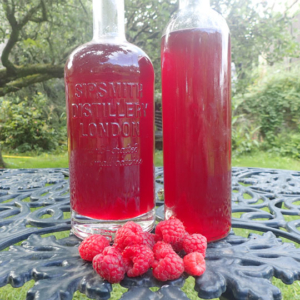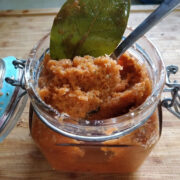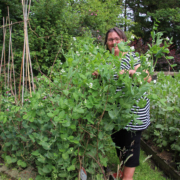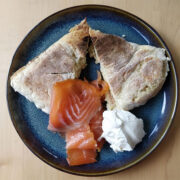Raspberry Vinegar. Season: July and August.
Have you ever made your own raspberry vinegar? What a wonderful year for raspberries 2022 is! We’re picking around a kilo every day here in the Bridge Cottage Garden. Do you grow raspberries? They are very easy to grow and here in the northeast of England they are very well suited to our climate.

Raspberries in the Bridge Cottage Garden in July
Raspberry picking takes me back to a summer job I once had, travelling by train from Worthing to Inverness as a seventeen-year-old to work on a fruit farm in Inverness picking raspberries. It was hard graft, with a double bucketed punnet tied around our necks. The boss would rattle out tents, and we’d emerge, hungover from a night at the local pub, The Bogroy, and traipse into the raspberry fields. We were a mixed bag, and I’d joined the party element – we shocked the straighter students by holding a naked raspberry picking day, wearing nothing but our wellies!

Raspberry vinegar
But enough of naked raspberry picking. What to do with all these raspberries? Jam making and ice cream spring immediately to mind, and I’ve already written pieces on that, which you’ll find along with lots of other seasonal recipes in the Bridge Cottage Kitchen.
Health Benefits of Raspberry Vinegar
However, that’s quite enough of naked raspberry picking. Time to get back on track. Today’s writing concerns the making of raspberry vinegar. Not only is it delicious, but it’s healthy too. Raspberry vinegar is an age-old remedy for sore throats, coughs and colds, did you know? It contains ellagic acid, a known cancer fighter and has antioxidants by the bucketload. Pam Corbin, in the River Cottage Series No. 2. Preserves, ( a kitchen bible in this house) writes: ‘During the nineteenth century, raspberry vinegar, in particular, was recommended as a refreshing tonic to overcome weariness.’
Culinary Uses
Nigel Slater advises us to pour it over ice cream and use it to deglaze the roasting tins of lamb or liver, giving a ‘fruity depth to the caramelised juices in the pan’. My husband, Tim, drinks it with fizzy water/soda and it goes equally well with tonic – very healthy. I love to make a fruity salad dressing mixing equal parts with olive oil. It is the perfect accompaniment to cheese, and delicious drizzled over a goat’s cheese and beetroot salad. (Thought Tim says beetroot is the food of the devil).
Method.

Raspberry vinegar
So here’s how, and it’s really easy!
Makes 1.5 litres
1kg raspberries
600ml cider vinegar or white wine vinegar
Granulated sugar
Put the raspberries in a bowl and crush them with the back of a wooden spoon. Add the vinegar. Cover and leave to steep for 4-5 days, stirring occasionally.
Pour the fruit and vinegar into a jelly bag, or piece of muslin suspended over a bowl. We use a piece of cheesecloth, tied at all four corners and hung off a kitchen cupboard door, with a large bowl underneath to catch the drips. Leave to drain overnight.
Measure the liquid then pour it into a saucepan.
It’s important you use a stainless-steel saucepan for this next bit and not aluminium as that would react with the vinegar. For every 600ml fruit vinegar, add 450g of sugar. Boil for 8-10 minutes, removing any scum as it gathers. Take off the heat and allow it to cool.
Bottle in sterilised glass bottles (we save these all year round for such times) Will keep for 12 months until it’s summer again and time to make some more.
Variations
We’ve made fruit vinegar with elderberries in autumn, gooseberries and blackcurrants and blackberries. All delicious!
As ever, we’d love you to share your thoughts, either by leaving a comment here or on our social media pages, where this article will be shared.
You can find the Bridge Cottage Way on Facebook Twitter and Instagram.
You might enjoy some of the writing and ideas in other sections of this website, as we look towards leading more sustainable lives by growing our own food and creating dishes in line with seasonal eating, or head to our handy ‘Month by Month’ guides to find out what we have been doing here at Bridge Cottage as the months go by:
- Sustainable Living
- The Bridge Cottage Garden
- The Bridge Cottage Kitchen
- Month by Month
- Seasonal Recipes
- Foraging – Food for Free
Many thanks for reading.
With Facebook and Instagram algorithms being fickle friends at times, be sure to get all new posts from The Bridge Cottage Way by signing up for the mailing list below. This will go our four times a year, with the seasons in Spring, Summer, Autumn and Winter. We, of course, will not share your details with third parties, and you have the right to unsubscribe at any time.
Sign up to quarterly Substack newsletter




 the Bridge Cottage Way
the Bridge Cottage Way The Bridge Cottage Way
The Bridge Cottage Way Sue Reed
Sue Reed
 The Bridge Cottage Way
The Bridge Cottage Way The Bridge Cottage Way
The Bridge Cottage Way he Bridge Cottage Way
he Bridge Cottage Way The Bridge Cottage Way
The Bridge Cottage Way
Leave a Reply
Want to join the discussion?Feel free to contribute!